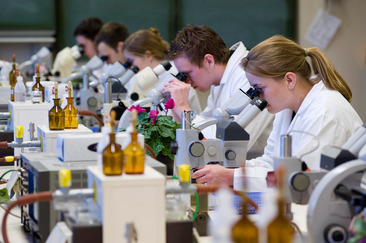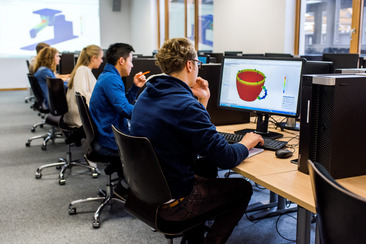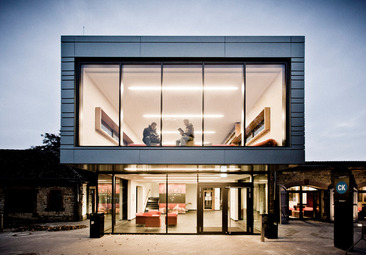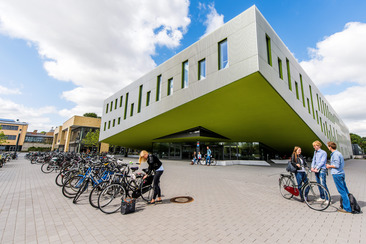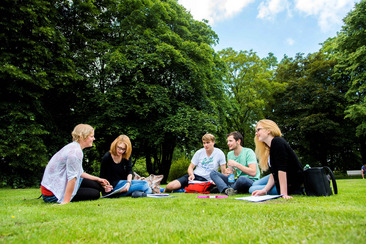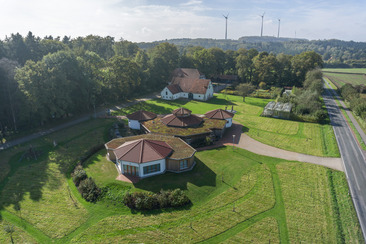WIR portrait
This is what the Osnabrück University of Applied Sciences stands for
The Osnabrück University of Applied Sciences has a high reputation in the region and far beyond. It is the largest and highest performance university of applied sciences in Lower Saxony. Four faculties (Agricultural Sciences and Landscape Architecture, Engineering and Computer Science, Management, Culture and Technology in Lingen, as well as Business Management and Social Sciences) and the Institute of Music form the backbone of the university at the two locations in Osnabrück and Lingen.
With around 110 degree programs, the Bachelor's, Master's and advanced training levels is truly comprehensive. Our university has been a pioneer in many areas of academic training – in the establishment of new degree programs, for example – and has thus earned the reputation of being an innovative and progressive institution of higher education. Now with 13,000 students (as of 2024/2025), our ever-growing university has reached an impressive size. Nonetheless, it has cultivated and maintained the character of a familiar and personal place of teaching and learning.
Lower Saxony's strongest research university
We are the strongest research university in Lower Saxony, with good networking in business, society and the scientific community. Our research and transfer strength is one of our outstanding features in terms of scope, breadth and quality. We focus on transformation-relevant topics and thus make an important contribution to a positive future for our society, regionally, nationally and internationally.
As visionary and responsible initiators, our researchers work on application-oriented contributions to solving current and future challenges. This is done in an interdisciplinary and focussed manner in our three research fields:
- Agriculture and Food Systems, Landscape and Urban Development
- Health, Society and Economy
- Sustainable Technologies and Processes.
The range of research topics within the research focus fields is considerable and ranges from drive and mobility solutions, health and supply innovations, nutrition and agricultural technologies, material sciences, landscape and urban development to computer science and artificial intelligence.
Home-grown research funding
In addition, Osnabrück University of Applied Sciences is currently funding two in-house research priorities (BFSP) that are particularly innovative in nature. The EN ROUTE focus area develops concepts and strategies for sustainable travelling in the university context. The SPINE project is dedicated to the potential applications and effects of artificial intelligence.
Modern infrastructure
The university is a member of the University Alliance UAS7. In this consortium, seven universities of applied sciences from all over Germany cooperate to advance their international orientation. There are UAS7 offices in New York and São Paulo. Due to the strength of its research, the university is also a member of the European University Association (EUA). The network of international relations is large and includes more than 300 partner universities all over the world. In 2013, the Hochschulzentrum China (HZC) was founded at the university.
The new, modern campus in the Lingen locomotive sheds, a new laboratory in the field of food science, new canteens at the Westerberg and Lingen locations, a new lecture hall and the new library at the campus of Westerberg: These are only a few examples of how a modern infrastructure has been created in recent years. The university is continuously active in this field.
Grown in and with the region
The Lingen Campus has been integrated in the former railway repair plant; the new cafeteria at Westerberg blends in to the overall architectural picture of the former Von Stein Barracks with its bright facing bricks. And the Teaching and Research Center Food Science has found a stylish home in the heritage-listed Osnabrück countryside restaurant "Schmied im Hone". These buildings contain an inherent message: The university has grown in and with the region.
An employer for more than 1,300 people
The Osnabrück University of Applied Sciences was founded in 1971. With effect from 1 January 2003, it passed into the sponsorship of the Stiftung 'Fachhochschule Osnabrück’ as an incorporated foundation under public law. This provides us with important design leeway while demonstrating a significant sign of trust from the country with regard to the university's performance. For the university, it was of particular value in the recent years to be able to quickly respond to the growing needs in the personnel area. Also as a building owner, we can specifically meet the needs of the faculty, researchers and students. In the amendment to the NHGs from June 2010, the Fachhochschule Osnabrück was renamed Hochschule Osnabrück.
The university provides jobs for more than 320 professors and in total for approximately 1.300 employees. The aim is to give maximum possible development opportunities to all university staff and to create framework conditions that support the balance of family and career.
Socially committed
The Osnabrück University of Applied Sciences sees its responsibility as not only providing technical and transferable skills, but shaping attitudes and promoting open-minded personalities with their offers within the framework of a course of studies. Also in the approach of social commitment lies the opportunity for a transregional profiling of the university
We take our social responsibility seriously and are actively committed to climate protection. Through various measures, the university was able to reduce its CO2 emissions per person by almost 70 percent by the end of 2018 compared to 2008.
We hope that our students stay curious and test themselves at this particular stage of life. They should take time - in any form whatsoever - to commit themselves to the common good or to gain experience abroad. It is important for personal development to study conscientiously and it is also important to use the existing scope of development outside of studies.
In short: Osnabrück University of Applied Sciences has the space and freedom for successful study and research.

